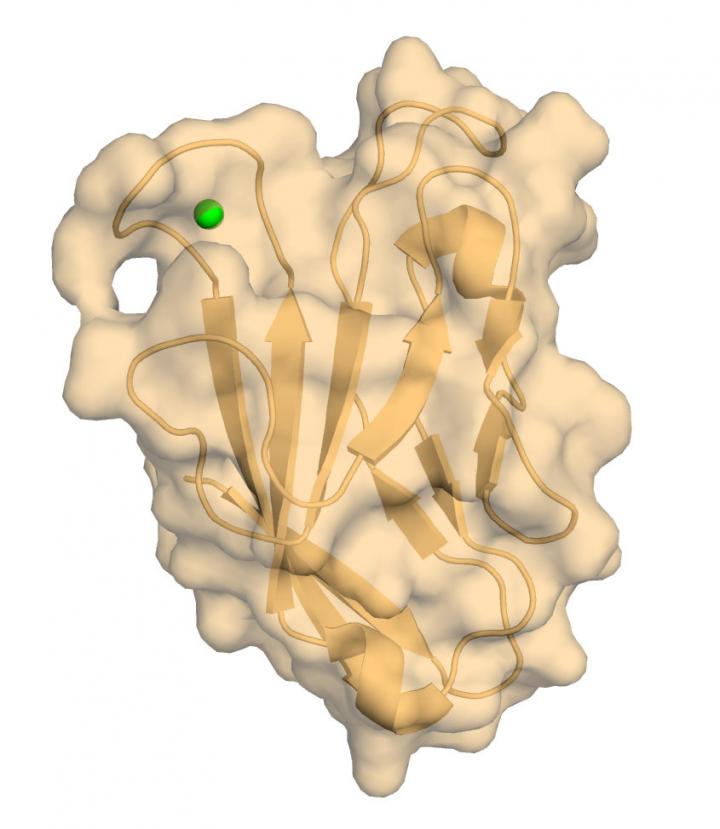Researchers image atomic structure of important immune regulator

This is a human TIM-3 with bound calcium. Credit: Richard Blumberg, Brigham and Women's Hospital Usage Restrictions: Reporters may use this image in news coverage of this study with credit to Richard Blumberg, Brigham and Women's Hospital
A new study by investigators from Brigham and Women's Hospital provides a biophysical and structural assessment of a critical immune regulating protein called human T-cell immunoglobulin and mucin domain containing protein-3 (hTIM-3).
Understanding the atomic structure of hTIM-3 provides new insights for targeting this protein for numerous cancer and autoimmune therapeutics currently under clinical development. The findings of this study were published online in Scientific Reports on Nov. 30.
“The hTIM-3 protein is an important immune regulator, yet it has been difficult to target for drug development as high-resolution structure conformational details have been elusive,” said senior author Richard Blumberg, MD, chief of the Division of Gastroenterology, Hepatology and Endoscopy in the Department of Medicine at the Brigham. “We resolved the structure of hTIM-3 and established a novel biochemical assay to define its functionality, which will be useful for understanding the role of hTIM-3 in the immune system.”
The team captured a high-resolution X-ray crystal structure and nuclear magnetic resonance (NMR) image of the hTIM-3 IgV domain that is involved in functional interactions with CEACAM1, which is a crucial immune escape mechanism for many cancers. Importantly, the team determined the precise location of a calcium atom, an essential co-factor, bound to the hTIM-3 IgV domain.
“This is the first NMR analysis of any immune-related TIM molecule and the first high resolution structural report of the hTIM-3 IgV domain with association of critical co-factors such as calcium,” said author Amit Gandhi, PhD, a researcher in Blumberg's laboratory in the Department of Medicine. “No one has been able to do this before. Hopefully this will help with the targeting of human hTIM-3 and the development of useful therapeutics.”
“This structure shown here represents a high resolution, physiologically relevant hTIM-3 molecule,” said author Walter Kim, MD, PhD, a researcher in Blumberg's laboratory and associate physician in the Department of Medicine. “Now we can understand what specific regions of the protein are accessible for therapeutic drugs to bind.”
###
The NMR structural studies were led by Zhen-Yu Jim Sun, PhD, a researcher at Harvard Medical School. Funding for this work was supported by the NIH Grants 5R01DK051362-21 and the High Pointe Foundation to R.S.B. and 5P01AI073748-09 to V.K.K., and GM047467 and AI037581 to G.W.
Paper cited: Gandhi, A et al. “High resolution X-ray and NMR structural study of human T-cell immunoglobulin and mucin domain containing protein-3” Scientific Reports DOI: 10.1038/s41598-018-35754-0
Media Contact
More Information:
http://dx.doi.org/10.1038/s41598-018-35754-0All latest news from the category: Health and Medicine
This subject area encompasses research and studies in the field of human medicine.
Among the wide-ranging list of topics covered here are anesthesiology, anatomy, surgery, human genetics, hygiene and environmental medicine, internal medicine, neurology, pharmacology, physiology, urology and dental medicine.
Newest articles

First-of-its-kind study uses remote sensing to monitor plastic debris in rivers and lakes
Remote sensing creates a cost-effective solution to monitoring plastic pollution. A first-of-its-kind study from researchers at the University of Minnesota Twin Cities shows how remote sensing can help monitor and…

Laser-based artificial neuron mimics nerve cell functions at lightning speed
With a processing speed a billion times faster than nature, chip-based laser neuron could help advance AI tasks such as pattern recognition and sequence prediction. Researchers have developed a laser-based…

Optimising the processing of plastic waste
Just one look in the yellow bin reveals a colourful jumble of different types of plastic. However, the purer and more uniform plastic waste is, the easier it is to…



